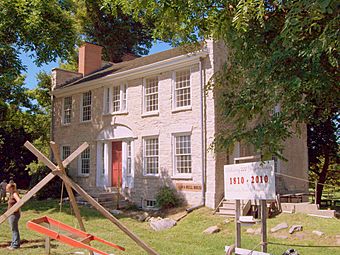Warren Hull House facts for kids
Quick facts for kids |
|
|
Warren Hull House
|
|

Warren Hull House, August 2010
|
|
| Location | 5976 Genesee St., Lancaster, New York |
|---|---|
| Built | 1810 |
| Architectural style | Late Victorian, Federal |
| NRHP reference No. | 92000456 |
| Added to NRHP | May 11, 1992 |
The Warren Hull House is a very old and important home located in Lancaster, New York. It was built around 1810 by Warren Hull, who was one of the first settlers in Erie County, New York. This house is special because it's built in the Federal style. It also has the family's burial ground right behind it.
What makes the Warren Hull House truly unique is that it's the oldest stone house in all of western New York! Today, the Hull Family Home Association takes care of it. The house was added to the National Register of Historic Places in 1992, which means it's recognized as a very important historical site. You can visit the Hull House on special "Open House" days in the spring, summer, and fall. If you have a group, you can even schedule a tour by visiting their website.
Contents
A Look Back: History of the Hull House
Over 200 years ago, a couple named Warren and Polly Hull traveled a long way from Connecticut. They moved through different parts of New York State before finally choosing to build their forever home. They settled on what is now Genesee Street in Lancaster.
Building a Stone Home in the Wilderness
The land for their home and farm was bought in 1804. At that time, this area was part of the Town of Clarence. Later, in 1831, it became part of the Town of Lancaster. The Hull House was built around 1810. Most homes back then were made of wood, so a stone house like theirs was quite rare. There's even an old wooden cabin, called the Gipple Cabin, that was moved to the property in 2013. It's one of the oldest wooden cabins in the area.
Changes Over the Years
The Hull family owned the house until the mid-1800s. After that, many different families lived there, including the Wolfs and the Petersons. In the 1950s, when Frank Wolf owned the house, a big part of the property was lost. This happened because the New York Thruway, a major highway, was built right through the land.
Later, in the late 1900s, the house started to fall apart. The property was used for yard sales and became a bit messy.
Saving the Historic Home
When the Hull Family Home Foundation started its work in 1992, the house and barn were in bad shape. But thanks to their hard work, the home has been restored. Now, it's a wonderful historical site that people can visit. The foundation even plans to rebuild the property to look like an early 19th-century farm, complete with old-fashioned outbuildings.
Meet the Hull Family
Warren Hull (born 1762, died 1838) married Polly Gillett (born 1765, died 1834) in 1783. Before he got married, Warren fought in the Revolutionary War alongside his father.
A Pioneer Family's Journey
Before settling in western New York, Warren and Polly lived in several other counties in the state. As they moved west, their family grew. By the time they bought their land in 1804, they already had ten children!
It's hard to imagine how this large family lived in what was then a wild area in 1804. Warren and Polly were smart and educated. They knew how to use the resources around them. They worked their farm and took their crops and wood to nearby mills. Polly likely taught her children at home until a schoolhouse was built nearby.
The Children of Warren and Polly Hull
After Warren and Polly passed away, their daughter Polly Hull Lewis lived in the family home. She had six children and became a widow in 1830.
Many of the Hull children stayed in the Lancaster area. However, some of their children and grandchildren moved further west. They settled in states like Ohio, Indiana, Illinois, and Wisconsin.
Here are the names and birth/death years of Warren and Polly's children:
- Polly: 1786–1863
- Rebecca: 1788–1871
- James: 1789–1867
- Anna: 1791–1851
- Maria: 1793–?
- Edmund: 1795–1852
- Justus: 1797–1863
- Sophia: 1799–1866
- Miranda: 1802–?
- Minerva: 1804–1830
- Aurilla: 1805–1898
- Vilera: 1808–1835



